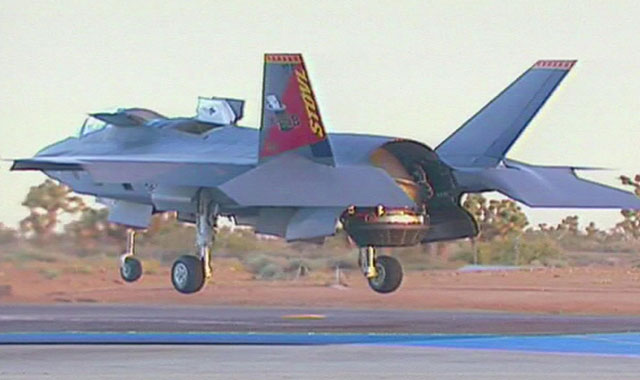The F35B jump-jet variant for Royal Navy aircraft carriers
The Government’s U-turn on which of the American stealth fighters to order for Britain's new aircraft carrier, the Queen Elizabeth, reveals at least it is capable of recognising a bad decision.
The issue lies in how and why the about-turn was necessary at all.On paper, just one letter separates the two types of fighter - B and C.
They are made by the same company, Lockheed Martin, and both based on technology which makes them almost invisible to modern radar and thermal tracking systems.
But the F-35B is a short take-off vertical landing (STOVL) aircraft.
The F-35C is conventional.
The Queen Elizabeth is currently under construction in Scotland.
She was designed with a STOVL fighter in mind and built into her shape is the distinctive "ski-jump" bow which helps it to get into the air from a short run-up.
Two years ago, the STOVL was not looking good. In trials it struggled to hover anything like the more primitive Harrier jump jet and was put on "probation" by the US Government, which was developing it for the Marine Corps.
The new Government faced a £39bn black hole in its finances and, as part of a cuts programme, it announced it would mothball one of the two carriers, the Prince of Wales.
On top of that it said, rather than the F-35B jump jet it was opting for the F-35C, the "carrier variant".
It acknowledged the new Queen Elizabeth carrier would have to be adapted with catapults and stopping gear - "cats and traps" - estimating these would cost £700m, soon revising this to £900m.
The conventional F-35C has a longer combat range, 600 nautical miles compared with 469.
It can carry a bigger payload - and was lauded at the time by the Government as a better more flexible aircraft.
In 2010, Prime Minister David Cameron announced the adoption of the conventional aircraft saying: "This is another area where I believe the last government got it badly wrong.
"The carriers they ordered were unable to work effectively with our key defence partners, the United States or France.
"They ordered the more expensive and less capable version of the joint strike fighter to fly off the carriers.
"That is the legacy we inherited, an appalling legacy the British people have every right to be angry about, but I say to them today: we will act in the national interest."
He added the F-35B was "more capable, less expensive, has a longer range and carries more weapons".
In the Commons two years later, Philip Hammond, the Defence Secretary, was forced to admit that in fact the decision to abandon the jump jet fighter had to be reversed in view of "unacceptable cost growth and project delays".
Mr Hammond told Sky: "It may be inconvenient but the decision taken two years ago was based on the best information available at the time.
"Now there is much more data so we are in a position that allows us to make a more informed decision which will mean that we can have the option to have two aircraft carriers if that's what we decide to do in 2015."
Whitehall sources squirmed uncomfortably during briefings when they were asked to explain how the decision to dump the jump jet was taken given that two years later this was clearly a bad idea.
Officials estimate now that the cats and traps would cost another £1bn, and would require 290 major modifications to the ship.
Training in the use of the conventional aircraft would take longer adding to the expense.
And if the Prince of Wales was mothballed, as planned, to help pay for the adjustments to the Elizabeth, then the Elizabeth would be out of service for a third of its time on maintenance leaving the Royal Navy without an aircraft carrier for large chunk of time.
The carriers and aircraft will now be ready by 2018, not 2023, it will save £1bn in not having cats and traps, and both carriers might be useable.
So on balance, the U-turn makes sense. The question is: why was it necessary at all?















0 comments:
Post a Comment